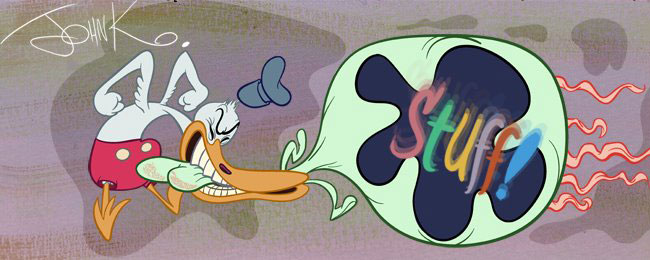
In the "Solid Drawings" chapter of "The Illusion Of Life", Thomas warns us about using "twins" in our poses. It's a good point, but I'm not sure what it has to do with solid drawing. That's why I didn't include it in yesterday's post. It's more about keeping our characters from looking monotonous, wooden or dead.






Avoiding "twins" is merely one aspect of asymmetry which I have covered in other posts. I recommend for all aspects of your drawings: the design, the pose, the proportions - to not be exact mirror images of their opposite sides. You won't find anything in life to be perfectly symmetrical - except maybe for robots. Symmetry looks unnatural and dead.
 This drawing from the "twins" model sheet has a very symmetric robotic face. The page warns against "twinning" in the pose, but not in the design or expression.
This drawing from the "twins" model sheet has a very symmetric robotic face. The page warns against "twinning" in the pose, but not in the design or expression. Compare to this looser more natural Freddy Moore face. Nothing on the left side of his face matches exactly the shape and size of its counterpart on the right. ***ALSO**** and this is very important - nothing on TOP of a shape is the same as the BOTTOM of the shape. The eyes are not only different from each other...each eye itself is a different shape on the left and right ...AND on the top and bottom. They are asymmetrical in every dimension - just like your own face and mine.
Compare to this looser more natural Freddy Moore face. Nothing on the left side of his face matches exactly the shape and size of its counterpart on the right. ***ALSO**** and this is very important - nothing on TOP of a shape is the same as the BOTTOM of the shape. The eyes are not only different from each other...each eye itself is a different shape on the left and right ...AND on the top and bottom. They are asymmetrical in every dimension - just like your own face and mine. The heads in the drawings from "Illusion of Life" that warn us against "twins" in the posing of Micky, don't follow the same theory on the design. Mickey's head is a perfect circle and his eyes are perfect ovals.
 Here is a pose that is asymmetric and each part of the design is asymmetrical - very natural without being "realistic". It's still a cartoon mouse, but one that seems alive.
Here is a pose that is asymmetric and each part of the design is asymmetrical - very natural without being "realistic". It's still a cartoon mouse, but one that seems alive. It's important to note that even with all this natural unevenness, all the features still wrap around the bigger shapes in the right dimensions - organic and constructed mixed together.
It's important to note that even with all this natural unevenness, all the features still wrap around the bigger shapes in the right dimensions - organic and constructed mixed together. It's hard to avoid "twins" in your poses every time. Even Freddie Moore does it sometimes. But you don't notice it, because every part of the design itself is fluid, uneven and natural ..."Organic".
It's hard to avoid "twins" in your poses every time. Even Freddie Moore does it sometimes. But you don't notice it, because every part of the design itself is fluid, uneven and natural ..."Organic". These Moore models from "The Little Whirlwind" show just about every fundamental Disney principle working at the same time - all in balance. To balance so many different skills all at the same time is not easy. To Moore, it came naturally. He was lucky - gifted from the 12,000 Gods above (choose the ones you believe in) .
These Moore models from "The Little Whirlwind" show just about every fundamental Disney principle working at the same time - all in balance. To balance so many different skills all at the same time is not easy. To Moore, it came naturally. He was lucky - gifted from the 12,000 Gods above (choose the ones you believe in) .http://fredmoore.blogspot.com/
For most of us, we have to learn each principle one at a time and then put them together slowly as we start to understand them. Eventually, they all become instinctive and we stop thinking about them. At that point, our drawings finally stop looking stiff and come to life. It's a lot of study and work - and PRACTICE PRACTICE PRACTICE.
 Once you have "solid drawing" working for you, you can start on "appeal" and "organic", but without the solid drawings, everything will be uncontrolled and mushy.
Once you have "solid drawing" working for you, you can start on "appeal" and "organic", but without the solid drawings, everything will be uncontrolled and mushy. All these poses were not created to be a model sheet. The models were made after the fact, from Moore's animation in the cartoon. They are key poses: the poses that tell the story in continuity.
All these poses were not created to be a model sheet. The models were made after the fact, from Moore's animation in the cartoon. They are key poses: the poses that tell the story in continuity.Creating model sheets out of your head with no story context or continuity to draw from is a futile and stodgy exercise. The best models are done like this.
When you have a story to work from and are drawing poses straight ahead with a purpose to them, the poses are much more natural. Because each one has a real meaning, rather than an abstracted pose made up by an official model-sheet designer who may or may not even be an animator.
I know from direct experience that the poses I draw when I am storyboarding, drawing layouts or animating are much more natural and lively than when I just try to design a character and make up a random pose for him (or her).
 http://www.michaelspornanimation.com/splog/?p=1357
http://www.michaelspornanimation.com/splog/?p=1357Twins and symmetry were avoided like the plague in the best cartoons of the Golden Age of cartoons.
Not to worry though, you can still find twins and perfect symmetry however in the more sophisticated prime time cartoons at night.

